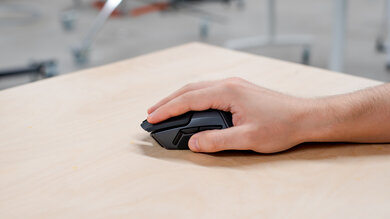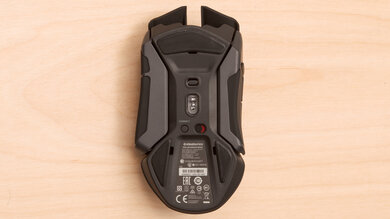The SteelSeries Rival 650 Wireless is a decent gaming mouse. It's the first wireless mouse in SteelSeries' lineup, and it's nearly identical to the wired SteelSeries Rival 600. It has an incredible sensor with a wide CPI range, minimal CPI error, and low click latency. It has a depth sensor that's supposed to reduce the lift-off distance to 0.5 mm, but we don't test for this. Although it's on the heavy side, it comes with eight 4-gram weights if you want to make it even heavier. It's extremely comfortable for any grip type, but it may be too big for smaller hands. Even though it's wireless, you can only use it with its proprietary USB receiver.
Our Verdict
The SteelSeries Rival 650 is a great office mouse. It's extremely comfortable, but it's too big for people with small hands to use with any grip type. It has a lot of buttons you can reprogram, which helps with your workflow. It's wireless, keeping your setup clean, but you can only use it with its proprietary receiver.
-
A lot of programmable buttons.
-
Suitable for medium to extra-large hands with any grip type.
-
Fully compatible with macOS and Windows.
-
Too big for small hands.
-
Wireless connectivity limited to its USB receiver.
-
You lose three side buttons when remove side panels.
The SteelSeries Rival 650 is decent for FPS gaming. It's a bit on the heavy side, but you can also remove the side panels to make it lighter. It's an extremely comfortable mouse, and it works well with any grip type, but it's too big for small hands. It has an incredible sensor with a wide CPI range, minimal error, and low lift-off distance. It also has low click latency, which is great.
-
Wide CPI range.
-
High polling rate.
-
Low click latency.
-
On the heavier side.
-
Too big for small hands.
-
You lose three side buttons when remove side panels.
The SteelSeries Rival 650 is great for MMO gaming. The mouse has a lot of programmable inputs, but it's limited to only three side buttons. It has an incredible sensor with low click latency, a high polling rate, low CPI error, and short lift-off distance. It's also extremely comfortable for medium or large-sized hands, and it's suitable for any grip type.
-
Low lift-off distance.
-
High polling rate.
-
Low click latency.
-
A lot of programmable buttons.
-
Too big for small hands.
-
Limited to three side buttons.
-
You lose three side buttons when remove side panels.
The SteelSeries Rival 650 is okay for travel, but it's a bit on the bulky side and doesn't have a slot to place the USB receiver. Sadly, it doesn't have any Bluetooth support. It's extremely comfortable, and the body feels solid, so you shouldn't have any issues tossing it into a bag.
-
Suitable for medium to extra-large hands with any grip type.
-
Fully compatible with macOS and Windows.
-
On the heavier side.
-
Wireless connectivity limited to its USB receiver.
-
You lose three side buttons when remove side panels.
- 7.6 Office/Multimedia
- 8.0 Video Games (FPS)
- 8.1 Video Games (MMO)
- 6.9 Travel
Changelog
- Updated Feb 22, 2023: We've converted this review to Test Bench 1.3. This update adds a new Sensor Latency test and makes minor changes to several of our existing tests, resulting in test result changes in several sections. For more information, you can check out our full changelog here.
- Updated Dec 09, 2022: We've converted this review to Test Bench 1.2. This update simplifies our Weight test and expands on our CPI test from Test Bench 1.1, resulting in changes to test results in both sections. For more details, you can see our complete changelog here.
- Updated Nov 21, 2022: We've added explanatory text to the Click Latency section to provide added context for our results following the update to Test Bench 1.1.
- Updated Nov 17, 2022: We've converted this review to Test Bench 1.1. This update revamps our Click Latency test and results in changes to test results. For more details, you can see our full changelog here.
- Updated Oct 20, 2020: Converted to Test Bench 1.0.
Check Price
Compared To Other Mice
The SteelSeries Rival 650 Wireless is a great overall mouse that's extremely similar to the SteelSeries Rival 600. Choosing between the two really comes down to personal preference and whether you like wireless or wired mice. However, the Rival 650 is pricey, and it's on the heavy side compared to other wireless mice, such as the Corsair HARPOON RGB Wireless.
Also, make sure to check out our recommendations for the best gaming mice, the best wireless mice, and the best SteelSeries mice.
The SteelSeries Rival 650 and the Logitech G Pro Wireless are similar mice. The Logitech is much lighter, is suitable for small hands, has a better sensor, and lower click latency. However, the SteelSeries has an extra programmable input, it's a lot more comfortable overall, and you can add weights to it.
The SteelSeries Aerox 5 Wireless and the SteelSeries Rival 650 are wireless gaming mice with very similar right-handed shapes designed to be versatile enough for a variety of game genres. The Aerox 5 Wireless has a honeycomb outer shell and is significantly lighter. It supports Bluetooth, and its sensor has a slightly wider CPI range. The feet are also of higher quality, and it has several more programmable buttons overall. On the other hand, the SteelSeries Rival 650 has a solid plastic shell, and it feels somewhat sturdier.
The SteelSeries Rival 600 and the SteelSeries Rival 650 are extremely similar mice. The 600 is a wired-only mouse that's lighter, and the 650 is wireless. The two mice have the same sensor, shape, and the same customization features.
The Logitech G903 LIGHTSPEED is slightly better than the Steelseries Rival 650. The Logitech is an ambidextrous mouse that's suitable for most grip types and hand sizes. It also has lower click latency, more buttons, and vertical wheel tilt. However, the SteelSeries is a right-handed mouse that feels more comfortable to use overall.
The SteelSeries Rival 650 is a bit better than the Razer Mamba Wireless. The SteelSeries feels more comfortable, and it's suitable for most hand sizes with a fingertip grip. It also has a lower lift-off distance, and the companion software is available on macOS. However, the Razer is lighter, has a wider CPI range, lower CPI increment steps, and lower click latency over its receiver.
The SteelSeries Rival 650 is better than the Corsair HARPOON RGB Wireless. The SteelSeries is better-built, feels more comfortable, has more buttons, and has a lower lift-off distance. However, the Corsair has Bluetooth support, it's lighter, and it has lower click latency over its USB receiver.
The Logitech G502 LIGHTSPEED performs a bit better than the SteelSeries Rival 650, and they both have very different designs. The Logitech is a wider mouse with an ergonomic shape and a thumb rest. It's a bit lighter, has more buttons, and has a better sensor overall. On the other hand, the SteelSeries is heavier and may feel slightly more comfortable for people who don't like having a thumb rest.
Overall, the Razer DeathAdder V2 Pro is much better than the SteelSeries Rival 650. The Razer is significantly lighter, has lower click latency, and allows you to adjust the sensitivity in smaller increments. On the other hand, the SteelSeries has a better build quality, and its customization software is available for both Windows and macOS.
If you like honeycomb design, the SteelSeries Aerox 3 Wireless is a better gaming mouse than the SteelSeries Rival 650. The Aerox is designed for ultra-light gaming and is smaller and significantly lighter. It's well-suited for a claw grip or even a fingertip grip if you have medium to large hands. Performance-wise, it has a wider CPI range with less variation. That said, the Rival 650 feels quite a bit more solid, and its right-handed design is more comfortable, though it's not a good option for smaller hands. It also has one more side button.
Test Results
The SteelSeries Rival 650 looks a lot like the SteelSeries Rival 600. It has a gamer-friendly design with RGB lighting on the logo, scroll wheel, and two strips on the body. It's mainly black with some gray accents throughout, and there are grips on the side panels.
Despite being a wireless mouse, the SteelSeries Rival 650 is a bit difficult to carry around. It's on the bulkier side, and there's no storage for the USB receiver. If you'd like a wireless mouse with receiver storage, check out the DELUX M800 Wireless.
The mouse has an excellent build quality. It has an all-plastic body that feels solid and squeaks a bit when you squeeze it. The clicks feel nice and satisfying, but the scroll wheel feels loose. Unfortunately, if you squeeze the left side too hard, you can activate one of the side buttons.
There are reports that the side grips come off over time, but we don't test for long-term durability. The side grips feel nice on our unit, but if you experience any issues, let us know in the discussions below.
It's heavier than the SteelSeries Rival 600 because of its built-in battery. It comes with eight 4-gram weights that you can add underneath the side panels for weight optimization.
You can remove the side panels to make it lighter, but you lose the three side buttons, and the mouse would likely be less comfortable. We measured the minimum weight with the panels.
If you want a lighter wireless mouse, check out the Razer DeathAdder V2 Pro.
This mouse feels extremely comfortable. It has a slant designed for right-handed people, and the body has a good, soft feel to it. The side grips feel nice too. Unfortunately, it's big and may not be suitable for small hands.
The SteelSeries Rival 650 is a wireless mouse, but you can only connect to it through its wireless USB receiver. The scroll wheel's lighting acts as a battery indicator and you can use it while charging. The battery is rated to last 24 hours, but this isn't something that we test for. If you're interested in a similar mouse that has Bluetooth support, check out the ASUS ROG Pugio II. Or, for a mouse with both Bluetooth support and wireless charging using Qi standard devices, check out the Cooler Master MM831 or the HyperX Pulsefire Dart.
The included micro-USB rubber cable is decent, but kinks rather easily.
The SteelSeries Rival 650 has a ton of programmable buttons, and you can even reprogram the up and down on the scroll wheel. However, this may not be enough for some MMO players. If you want a mouse with a unique joystick on its left side, check out the ASUS ROG Chakram.
The SteelSeries Rival 650 has good click latency. You're very unlikely to notice any delays during gameplay in any genre; however, if you exclusively play fast-paced games at a highly competitive level, a mouse with lower click latency is recommended. If you're interested in a mouse with much lower click latency, check out the Corsair DARK CORE RGB PRO.
The Receiver Click Latency result is marginally lower than that of the Wired Click Latency result, which is unusual. However, this mouse was retested multiple times, and we're confident in the results. The Wired and Receiver results are calculated as averages from 200 data points, which you can see on the graph above. While the Wired click latency is marginally higher when expressed as an average, you can also see that there's slightly more variation in the wireless Receiver click latency data points, including both lower and higher points compared to the more steadily consistent wired connection results, which is expected behavior. In any case, using either connection type provides good performance, and you won't notice any click latency differences between them in-game.
There are two sensors on the mouse. One is the typical optical sensor for tracking found on all mice, and the other is a depth sensor, aimed at reducing the lift-off distance.
The SteelSeries Rival 650 Quantum Wireless gaming mouse has an incremented wheel, but sadly, you can't unlock it for infinite scrolling. It moves left and right because it's loose, but it doesn't tilt for horizontal scrolling.
The SteelSeries Engine 3 software is outstanding. It offers a ton of customization options, and it's available on both Windows and macOS. The mouse has onboard memory, making it easy to carry over your settings to another computer.
Comments
SteelSeries Rival 650: Main Discussion
Let us know why you want us to review the product here, or encourage others to vote for this product.

































